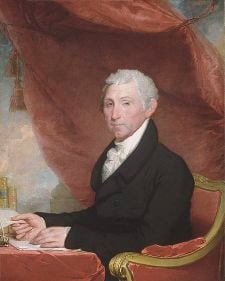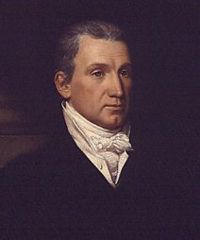James Monroe
| Term of office | March 4, 1817 â March 3, 1825 |
| Preceded by | James Madison |
| Succeeded by | John Quincy Adams |
| Date of birth | April 28, 1758 |
| Place of birth | Westmoreland County, Virginia |
| Date of death | July 4, 1831 |
| Place of death | New York City |
| Spouse | Elizabeth Kortright Monroe |
| Political party | Democratic-Republican |
James Monroe (April 28, 1758 â July 4, 1831) was a member of the U.S. Continental Congress, minister to France and Great Britain, governor of Virginia, U.S. senator, secretary of state, and fifth president of the United States. He was the last chief executive to personally fight for independence from Britain during the Revolutionary War.
Monroe was a popular president who ran unopposed for a second term in 1820. With the opposition Federalist Party effectively moribund, the eight years of Monroe's administration (1817-1825) were called the Era of Good Feeling. He was also the last American president of the âVirginia Dynastyââof the first five U.S. presidents, four were born and lived in Virginia.
As president, Monroe consistently and successfully pursued a policy that served both to protect the United States from European interference and to foster unhampered growth of the nation and its economy. He was responsible for the promulgation of the Monroe Doctrine, a major tenet of U.S. foreign policy asserting that the United States would not tolerate new colonies or interference by outside powers in the internal affairs of nations in the Western hemisphere. The 1820 Missouri Compromise addressed the contentious issue of slavery in newly admitted western states, but merely delayed the resolution of the issue of slavery until the U.S. Civil War in 1861-1865.
Monroe was a patriot of whom Jefferson reportedly said, "[He] was so honest that if you turned his soul inside out there would not be a spot on it."[1] Like his predecessors in the nation's highest office, Monroe also acknowledged the Creator with respect to America's rising fortunes: "When we view the great blessing with which our country has been favored, those which we now enjoy, and the means which we posses of handling them down unimpaired to our latest posterity, our attention is irresistibly down to the source from whence they flow. Let us, then, unite in offering our most grateful acknowledgments for those blessing to the Divine Author of All Good."
Family and early years
Born in Westmoreland County, Virginia, Monroe went to school at Campbelltown Academy and then the College of William and Mary, both in Virginia. Monroe's father, Spence Monroe, was a woodworker and tobacco farmer and mother Elizabeth Jones Monroe had significant land holdings, but little money. After graduating from William and Mary in 1776, Monroe fought in the Continental Army, serving with distinction at the Battle of Trenton, where he was shot in his left shoulder. Following his military service, he practiced law in Fredericksburg, Virginia. Monroe married Elizabeth Kortright on February 16, 1786, at the Trinity Church in New York.
Political Career
Monroe was elected to the Virginia House of Delegates in 1782 and served in the Continental Congress (1783â1786). As a youthful politician, he joined the anti-Federalists in the Virginia Convention which ratified the Constitution, and in 1790, was elected United States Senator. As Minister to France in 1794â1796, he displayed strong sympathies for the French Revolution; later, with Robert R. Livingston and under the direction of President Thomas Jefferson, he helped negotiate the Louisiana Purchase.
Monroe served as governor of Virginia from 1799 to 1802. He was minister to France again in 1803 and then minister to the Court of St. James from 1803 to 1807. He returned to the Virginia House of Delegates and was elected to another term as governor of Virginia in 1811, but he resigned a few months into the term. He then served as secretary of state from 1811 to 1814. When he was appointed to secretary of war on October 1, 1814, he stayed on as the interim secretary of state. On February 28, 1815, he was again commissioned as the permanent secretary of state, and left his position as secretary of war. Thus from October 1, 1814 to February 28, 1815, Monroe held the two cabinet posts. Monroe stayed on as secretary of state until the end of the James Madison presidency, and the following day Monroe began his term as the new president of the United States.
Presidency 1817-1825
Policies
Following the War of 1812, Monroe was elected president in the election of 1816, and re-elected in 1820. In both those elections Monroe ran nearly uncontested.
Attentive to detail, well prepared on most issues, non-partisan in spirit, and above all pragmatic, Monroe managed his presidential duties well. He made strong cabinet choices, naming a southerner, John C. Calhoun, as secretary of war, and a northerner, John Quincy Adams, as secretary of state. Only Henry Clay's refusal kept Monroe from adding an outstanding westerner. Most appointments went to deserving Republicans, but he did not try to use them to build the party's base. Indeed, he allowed the base to decay, which reduced tensions and led to the naming of his era as the "Era of Good Feeling."
To build goodwill, he made two long tours in 1817. Frequent stops allowed innumerable ceremonies of welcome and good will. The Federalist Party dwindled and eventually died out, starting with the Hartford Convention. Practically every politician belonged to the Democratic-Republican Party, but the party lost its vitality and organizational integrity. The party's Congressional caucus stopped meeting, and there were no national conventions.
Acquisition of Florida
Monroe's greatest achievements as president lay in foreign affairs. Ably supported by Adams, he made substantial territorial additions and gave American policy a distinctly national orientation. Monroe welcomed an opportunity to press Spain to cede Florida and define the boundaries of Louisiana. His chance came when General Andrew Jackson invaded Florida in 1818. In pursuit of hostile Indians, Jackson seized the posts of St. Marks and Pensacola, acts that many persons regarded as violations of congressional war powers. In the cabinet, Adams, an expansionist, urged Jackson's complete vindication, while Crawford and Calhoun demanded that he be reprimanded for exceeding his instructions.
Monroe chose a middle courseâthe posts were restored to Spain, but the administration accepted Jackson's explanation that his action had been justified by conditions in Florida. The incident led Spain to cede Florida and define, favorably to American claims, the boundary of the Louisiana Purchase in the Adams-OnĂs Treaty negotiated in 1819.
Missouri Compromise
The Missouri Compromise, also called the Compromise of 1820, was an agreement passed in 1820 between the pro-slavery and anti-slavery factions in the United States, involving primarily the regulation of slavery in the western territories. It prohibited slavery for all new states north of the 36°30' line, or the border of the Arkansas territory (excluding Missouri). Prior to the agreement, the House of Representatives had refused to accept this boundary and a conference committee was appointed. The United States Senate refused to concur in the amendment, and the whole measure was lost.
During the following session (1819-1820), the House passed a similar bill with an amendment introduced on January 26, 1820 by John W. Taylor of New York allowing Missouri into the union as a slave state. In the meantime, the question had been complicated by the admission in December of Alabama, a slave state (the number of slave and free states now becoming equal), and by the passage through the House (January 3, 1820) of a bill to admit Maine as a free state.
The Senate decided to connect the two measures, and passed a bill for the admission of Maine with an amendment enabling the people of Missouri to form a state constitution. Before the bill was returned to the House, a second amendment was adopted on the motion of Jesse B. Thomas of Illinois, excluding slavery from the Missouri Territory north of 36°30' (the southern boundary of Missouri), except within the limits of the proposed state of Missouri. The House of Representatives refused to accept this and a conference committee was appointed.
Monroe Doctrine
The 1823 Monroe Doctrine advance the U.S. position that European powers should no longer colonize the Americas or interfere with the affairs of sovereign nations located in the Americas, such as the United States, Mexico, and others. In return, the United States planned to stay neutral in wars between European powers and in wars between a European power and its colonies. However, if these latter type of wars were to occur in the Americas, the U.S. would view such action as hostile toward itself.
The doctrine was issued by Monroe during his seventh annual State of the Union address to Congress. It was met first with doubt, then with enthusiasm. This was a defining moment in the foreign policy of the United States.
The Monroe Doctrine states three major ideas, with one more added by President Theodore Roosevelt. First, it conveys that European countries cannot colonize in any of the Americas: North, Central, or South. Second, it advances George Washington's foreign policy of noninterference in European affairs if America's interests are not involved. Third, the U.S. will consider any attempt at colonization a threat to its national security. Roosevelt added to the doctrine, and summed up his additions with the statement, "Speak softly and carry a big stick."
Administration and Cabinet
| OFFICE | NAME | TERM |
| President | James Monroe | 1817â1825 |
| Vice President | Daniel Tompkins | 1817â1825 |
| Secretary of State | John Quincy Adams | 1817â1825 |
| Secretary of the Treasury | William H. Crawford | 1817â1825 |
| Secretary of War | John C. Calhoun | 1817â1825 |
| Attorney General | Richard Rush | 1817 |
| William Wirt | 1817â1825 | |
| Postmaster General | Return Meigs | 1817â1823 |
| John McLean | 1823â1825 | |
| Secretary of the Navy | Benjamin Crowninshield | 1817â1818 |
| John C. Calhoun | 1818â1819 | |
| Smith Thompson | 1819â1823 | |
| Samuel L. Southard | 1823â1825 | |
Supreme Court appointments
Monroe appointed the following Justice to the Supreme Court of the United States:
- Smith Thompson â 1823
States admitted to the Union
- Mississippi â December 10, 1817
- Illinois â December 3, 1818
- Alabama â December 14, 1819
- Maine â March 15, 1820
- Missouri â August 10, 1821
Post-Presidency
Upon leaving the White House after his presidency, James Monroe moved to live at Monroe Hill on the grounds of the University of Virginia. This university's modern campus was originally Monroe's family farm from 1788 to 1817, but he had sold it to the new college in the first year of his presidency. He served on the Board of Visitors under Jefferson and then under the second rector and another former President James Madison, until his death.
Monroe had racked up debts during his years of public life. As a result, he was forced to sell off his Highland Plantation. Today, it is owned by the College of William and Mary, which has opened it to the public. He never recovered from his financial troubles, and his wife's poor health made matters worse. As a result, he and his wife lived in Oak Hill until Elizabeth's death on September 23, 1830.
Following his wife Elizabeth's death, Monroe moved to live with his daughter Maria Hester Monroe Gouverneur in New York City and died there from heart failure and tuberculosis on July 4, 1831, 55 years after the U.S. Declaration of Independence was proclaimed and five years after the death of presidents John Adams and Thomas Jefferson. He was originally buried in New York, but he was re-interred in 1858 to the President's Circle at Hollywood Cemetery in Richmond, Virginia.
Other facts
- Apart from George Washington and Washington, D.C., James Monroe is the only U.S. President to have had a country's capital city named after himâthat of Monrovia in Liberia which was founded by the American Colonization Society, in 1822, as a haven for freed slaves.
- Monroe was the third president to die on July 4. John Adams and Thomas Jefferson both died on the same day, July 4, 1826, the fiftieth anniversary of the sighing of the Declaration of Independence.
- Monroe was the last president to have fought in the Revolutionary War, although Andrew Jackson served as a 13-year-old courier in the Continental Army and was taken as a prisoner of war by the British.
- In the famous painting of Washington's Delaware Crossing, Monroe is standing behind George Washington and holds the American flag.
- In the election of 1820, Monroe received every electoral vote except one. A New Hampshire delegate casted his vote on an unknown because he wanted Washington to be the only president to be elected unanimously.
Notes
- â "James Monroe," The White House
ReferencesISBN links support NWE through referral fees
- Ammon, Harry. James Monroe: The Quest for National Identity. Charlottesville : University Press of Virginia, 1990. ISBN 0813912660
- Cunningham, Noble E., Jr. The Presidency of James Monroe (American Presidency Series). Lawrence, KS: University Press of Kansas, 1996. ISBN 0700607285
- Dangerfield, George. The Era of Good Feelings. Norwalk, CT: Easton Press, 1986.
- Dangerfield, George. The Awakening of American Nationalism: 1815 - 1828. New York: Harper & Row, 1965.
- Holmes, David L. The Faiths of the Founding Fathers. New York : Oxford University Press, 2006. ISBN 9780195300925
- Holmes, David L. "The Religion of James Monroe." The Virginia Quarterly Review (Autumn 2003). Online version
External links
All links retrieved December 17, 2024.
- The Presidential Home of James Monroe (Ash Lawn-Highland)
- Monroe Doctrine and related resources at the Library of Congress
- James Monroe's Health and Medical History
- James Monroe Birthplace Commission
- InfoPlease- James Monroe
| Preceded by: John Walker |
United States Senator (Class 1) from Virginia 1790 â 1794 |
Succeeded by: Stevens T. Mason |
| Preceded by: Gouverneur Morris |
U.S. Minister Plenipotentiary to France 1794 â 1796 |
Succeeded by: Charles Cotesworth Pinckney |
| Preceded by: James Wood |
Governor of Virginia 1799 â 1802 |
Succeeded by: John Page |
| Preceded by: Rufus King |
U.S. Minister to Great Britain 1803 - 1807 |
Succeeded by: William Pinkney |
| Preceded by: John Tyler, Sr. |
Governor of Virginia 1811 |
Succeeded by: George William Smith |
| Preceded by: Robert Smith |
United States Secretary of State April 2, 1811 â September 30, 1814; February 28, 1815 â March 3, 1817 |
Succeeded by: John Quincy Adams |
| Preceded by: John Armstrong, Jr. |
United States Secretary of War 1814 â 1815 |
Succeeded by: William H. Crawford |
| Preceded by: James Madison |
Democratic-Republican Party presidential nominee 1816 (won), 1820 (won) |
Succeeded by: John Quincy Adams, Henry Clay, William Harris Crawford, Andrew Jackson(a) |
| Preceded by: James Madison |
President of the United States March 4, 1817 â March 3, 1825 |
Succeeded by: John Quincy Adams |
| |||||||
Credits
New World Encyclopedia writers and editors rewrote and completed the Wikipedia article in accordance with New World Encyclopedia standards. This article abides by terms of the Creative Commons CC-by-sa 3.0 License (CC-by-sa), which may be used and disseminated with proper attribution. Credit is due under the terms of this license that can reference both the New World Encyclopedia contributors and the selfless volunteer contributors of the Wikimedia Foundation. To cite this article click here for a list of acceptable citing formats.The history of earlier contributions by wikipedians is accessible to researchers here:
The history of this article since it was imported to New World Encyclopedia:
Note: Some restrictions may apply to use of individual images which are separately licensed.


